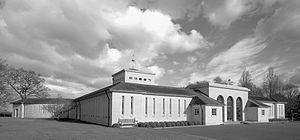Air Forces Memorial facts for kids
Quick facts for kids Air Forces Memorial, Runnymede |
|
|---|---|
| Commonwealth War Graves Commission | |

Showing portico entrance, look-out wing and astral crown surmounting the central chapel.
|
|
| For Commonwealth Air Forces dead of World War II with no known grave | |
| Unveiled | 17 October 1953 by HM Queen Elizabeth II |
| Location | 51°26′16″N 0°33′54″W / 51.4378°N 0.5650°W near Egham Surrey England
|
| Designed by | Edward Maufe |
| Commemorated | Over 20,000 Commonwealth Air Forces personnel including those with acting RAF, AuxAF or WAAF rank such as SOE operatives |
The Air Forces Memorial, also known as the Runnymede Memorial, is a special place in Englefield Green, near Egham, Surrey, England. It remembers over 20,456 brave men and women from the air forces of the British Empire. These people were lost during World War II and have no known grave. Their names are carved into the stone walls of the memorial.
Contents
What Does the Memorial Look Like?
The memorial was designed by Sir Edward Maufe. The sculptures were made by Vernon Hill. John Hutton designed the beautiful engraved glass and painted ceilings. A poem by Paul H Scott is carved on a gallery window. This building was the first one after World War II to be recognized for its amazing design.
Amazing Views from the Roof
From the roof of the memorial, you can see the River Thames and Runnymede Meadow. This is where the famous Magna Carta was signed by King John in 1215. On a clear day, you can see much of London, including the London Eye and the arch of Wembley Stadium. To the left, you can spot Windsor Castle and the area around it.
-
Air Forces Memorial Runnymede England - example coat of arms of the Commonwealth Nations (here Australia) of the commemorated
Where is the Memorial Located?
The memorial is on Coopers Hill Lane in Englefield Green. It is next to the former Runnymede campus of Brunel University. It is also near Kingswood Hall, which is part of Royal Holloway, University of London. This hall used to be a convent before 1965.
For a map showing its location near other Runnymede memorials, see Runnymede.
What is the Memorial's Status?
The Air Forces Memorial is a very important building. It is a Grade II* listed building, which means it has special historical or architectural importance. It was finished in 1953.
Who is Remembered at the Memorial?
The memorial lists the names of many brave individuals who served in the air forces. These include pilots, officers, and other personnel who lost their lives during World War II. Here are some of the notable people remembered:
- Flight Lieutenant Howard Peter Blatchford, a Canadian pilot who fought in the Battle of Britain.
- Flying Officer David Moore Crook, a skilled fighter pilot.
- Flight Lieutenant Arthur ('Art') Donahue, an American RAF Flying ace and author.
- Flight Lieutenant John Dundas, a flying ace.
- Wing Commander Brendan (Paddy) Finucane, another flying ace.
- Squadron Leader Hilary Hood, a pilot who died during the Battle of Britain.
- First Officer ATA Amy Johnson, a famous aviator.
- Pilot Officer Vernon ('Shorty') Keogh, an American RAF pilot in the Battle of Britain.
- Assistant Section Officer Noor Inayat Khan, who received the George Cross for her bravery as a secret agent.
- Flight Lieutenant Eric Lock, a flying ace.
- Pilot Officer William (Willie) McKnight, a Canadian flying ace.
- Wing Commander John Dering Nettleton, who received the Victoria Cross for his courage.
- Pilot Officer Esmond Romilly, a writer who spoke out against fascism.
- Pilot Officer Derek Teden, an England rugby international player.
- Wing Commander Alois Vasatko, a Czech flying ace.
- Squadron Leader Geoffrey Warnes from No. 263 Squadron RAF.
- Sergeant Leslie Lack, a football player for Arsenal F.C. before the war.
















